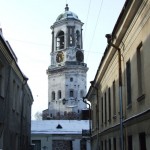Vyborg. Clock Tower
Looking at the panorama of old Vyborg one cannot help admiring the symmetry and harmony of the architectural appearance, which is created by correlation of its high-rise dominants. That is truly “the city of beautiful towers”! And each one has its own character, its own history.
St. Olaf’s Tower, the Rathaus Tower in the castle, the Round Tower, the Town Hall Tower, The Church of Transfiguration’s elegant belfry… They have all experienced years of prosperity and years of oblivion. But the most difficult fate befell the tower of the city’s clock, former belfry of the Cathedral Church and a fire tower, the Clock Tower. Closing the perspective of Water Gate Street, the Clock Tower nowadays became a popular Vyborg’s sight for tourists. Its viewing point above the clock affords an unusual view of the roofs of the old city, port cranes, a castle and ruins of a cathedral it was standing within one fence with to count Vyborg’s time and gather the city’s dwellers for church services. A church appeared in Vyborg, probably, as early as in the first half of XIV century. Maybe, at that time there already was a wooden belfry by the temple. In 1561, the temple was rebuilt, and a big bell was brought to Vyborg. By that time the belfry was already built of stone. The lower level of the Clock Tower is that very belfry, at that time not high and pretty massive. It can be supposed that the belfry of the Vyborg cathedral had also a defensive function which matches traditions of Medieval Sweden.
In 1600, on its wall a clock face was established, and since that time it became the Clock Tower. The Cathedral and its belfry frequently suffered from city fires. It caused rebuilding, remodeling, replacement of roof and bells.
In 1678, a fire in the city was so severe that the bells melted. After that event the tower was strengthened, overbuilt in the form of an octahedron, and the hip roof of the belfry received a new completion in the form of a broach with a weathercock.
In XVIII century, when the city was already part of the Russian Empire, the tower looked like “a stone…belfry with a wooden spire upon it and nine bells, of which two big ones and four small ones are broken, and intact are one, one clock and festive bell and one daily bell.” During a fire on June 17, 1738, the spire burnt and of all the bells only one was preserved. After another fire, during which in 1793 almost the entire city was burnt, the belfry was rebuilt according to governorate architect Johan Brokman’s design. On the old octahedron a new one with four semi-circular sound arches was erected. The clock from the lower octahedron was moved to the first level of the upper one. It was specially ordered from a Helsinki clockmaker Peter Elfstrem. At the same time an alarm bell was hung given to the city by Catherine II, and the tower, thus, became a fire tower. Inscriptions are preserved on the bell, “At the resuming of this belfry after a fire happening in the city of Vyborg in 1796” and “Cast in Moscow at Peter Strugovschikov’s factory. Weighs 61 poods.”
In 1848, a new clock works with 12- and 8-pood weights was installed. Old clock faces were replaced by new ones and two more were added – on the northern and southern walls. It was the last change of the Clock Tower’s appearance. During the WW II the Cathedral was destroyed, while the belfry survived and continues to faithfully serve the city. And reserved muffled strikes regularly can be heard from up high above Vyborg – it is the clock on the old tower continuing to count the hours.

